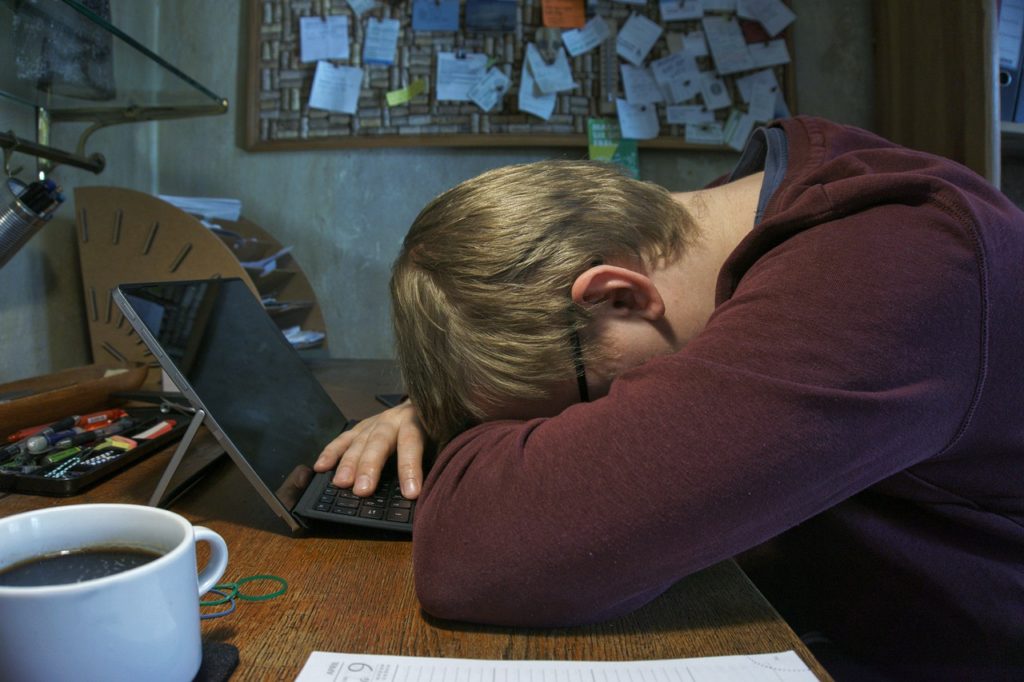
Have you or your employees been feeling work-from-home burnout and Zoom fatigue these past months despite the supposed convenience of working from home and using videoconferences to meet?
Is Work-From-Home Burnout All About the Job?
It’s true that burnout and other mental health issues have long existed in the US pre-COVID. However, there’s no denying that there’s been an increase in cases due to the turmoil brought about by the pandemic. Recent research shows that depression and anxiety have been on the rise since the pandemic started. Even more alarmingly, the study registered a consistent negative mental health score among Americans for the ninth month in a row. There’s also the bleak reality of joblessness in the US after the country’s labor market stumbled at the start of the pandemic and then continued to struggle as the virus continued to spread. As employees remain hyperaware of employment uncertainties, some tend to work with little consideration for physical or mental health just to ensure they feel secure in their job. All these moving pieces can only essentially lead down a disastrous road to poor mental health and burnout, which harm individual employees and companies alike. Let’s take the case of Matt, the CEO of an insurance company with a staff of 1,300, who had to find out the hard way just how serious work-from-home burnout can be. Matt had already been hearing some complaints from employees as early as May that managers were putting too much pressure on them and increasing their workloads. Many were also asking for some form of flexible scheduling as they struggled to share workspaces with spouses, their children, and other family members. All too soon, a growing number of employees also started to complain to HR about the poor communication and collaborative skills of some of their colleagues. The COO and head of HR dismissed the bad feedback, assuring Matt that these were just adjustment pains which would go away as the employees got used to working from home. Since he also had his hands full with other major projects and issues, Matt took them at their word and didn’t delve further into the situation – which turned out to be a big mistake.Work-From-Home Burnout in the Time of COVID
By mid-August, the growing resentment among the employees started to boil over, leading to serious infighting. Team members who were top performers pre-COVID declared that they were mentally exhausted and started showing problematic behavior. As the days passed, more and more complained of feeling burned out, accusing the company of blurring the lines between their work and personal lives. That doesn’t mean they didn’t like some aspects of working from home. In fact, an internal company survey indicated that about 30% preferred to work from home permanently; of the rest, 50% wanted to work remotely more than half the time even after the pandemic ended. It wasn’t the virtual nature of work that caused problems, it was how the company structured the work that led to problems. After the leadership team failed to address the problems on their own effectively, Matt decided to contact me in early October upon learning about my work through my webinar about how organizations can adapt to the changes brought by the pandemic. When he called me, morale and retention rates were dropping quickly. This issue clearly impacted company performance. Some angry clients called demanding an explanation for why their inquiries and concerns were being left unattended. Sales dropped in areas like life insurance, at a time when their competitors showed steady or even improving sales. It was clear that the company urgently needed help.Not an Emergency, But A New (Ab)Normal
When I met with Matt, the COO, and the head of HR (virtually, of course), we discussed how the virus isn’t going away anytime soon. Even with the successful vaccines, it will take many months before we can all go back to a semblance of how our work lives were before the pandemic. That’s especially true given the new COVID strains, some of which are more infectious and deadly, and less vulnerable to our vaccines. Matt even told me that they would love to figure out how to satisfy employee preferences for mostly-remote work after the pandemic, if the current issues could be addressed. The lease was coming up for renewal in December 2021, and the leadership felt that they could save significant money by moving to a much smaller location. Moreover, as in many organizations, the lack of a commute and other time savings led to higher employee productivity. Another benefit: if many employees worked from home permanently, they could then hire employees from anywhere, greatly expanding the talent pool available to them. Likewise, they could save money on salaries for employees who lived in lower-cost-of-living areas. Yet they couldn’t wrap their brains about how to address the work-from-home burnout. Without jumping this hurdle, both their short-term plans and their long-term ambitions couldn’t be realized. Many leaders are experiencing a similar situation at this time. My experience helping 9 companies- five startups, three established middle-market ones, and a business unit of a Fortune 300 company – do strategic pivots to adapt to COVID illustrated that work-from-home burnout represented the biggest internal threat of such pivots. The problem stems from companies failing to adapt internally to the impact of COVID and the post-COVID recovery. The vast majority failed to anticipate the long-term consequences of COVID, and had to make an abrupt shift to their employees working remotely. Everyone was in emergency mode, and adapted their existing ways of interacting in “office culture” to remote work. They focused, naturally and appropriately, on accomplishing the necessary tasks of the organization. However, they left behind the social and emotional glue that truly holds together internal teams and gives employees a sense of fulfillment and energy. That’s fine for an emergency, a week or two. Yet COVID is not an emergency. It’s a slow-moving train wreck, which will last until at least the end of 2021 if not longer. Moreover, it already has and will permanently shift many of our habits, norms, and values. Invariably, in all the companies for which I did strategic pivots, internal surveys illustrated results like Matt’s insurance company. In other words, many if not most employees preferred to work remotely more than half the time or even permanently. That’s a huge shift from previous surveys where a small minority wanted to work virtually, both within internal surveys and external surveys. What companies need to do is to stop thinking of COVID as an emergency situation to be handled via operational tactics. Instead, they need to approach COVID and the post-COVID world as our new abnormal reality, and use a strategic approach to survive and thrive in this new world. That includes a strategic re-evaluation of your internal structure, culture, and norms for a much more virtual environment for the foreseeable future. Otherwise, using office-style culture to conduct virtual work is simply forcing a square peg into a round hole. You can do it if you push hard enough, but you’ll break off the corners, in this case the social and emotional glue that bonds your employees into a company culture. That peg will do in an emergency, but in the longer run will wobble and eventually break.Recognize the 14 Problems Leading to Work-From-Home Burnout
Start the re-evaluation by recognizing the challenges brought by remote work in the age of COVID. Combining my expertise in emotional and social intelligence with research on the specific problems of working from home during COVID, I’ve identified a series of factors:- Deprivation of our basic human need for meaning and purpose. Perhaps the biggest problem is that the vast majority of us don’t realize we aren’t simply experiencing work-from-home burnout. We’re deprived of the fulfillment of basic human needs of meaning and purpose that we get from work. Our sense of self and identity, our narratives of ourselves and the sense of meaning-making we have in our lives, are tied to our work. That’s all severely disrupted by shifting to remote work.
- Deprivation of our basic human need for connection. At heart, we human beings are tribal creatures and long to feel connected and belong to a community. Our work community offers a key source of fulfillment of this sense of connection for many of us. We work together, we support each other, we celebrate each other’s triumphs and support each other through losses, we connect to something much bigger than ourselves. Work-from-home cuts us off from much of our ability to connect effectively to our colleagues as human beings, rather than little squares on a screen. This deprivation builds on being cut off from family members outside of our immediate household, our friends, community gatherings, and even our former outside hobbies and entertainment.
- Deprivation of building trust. In office settings, it’s easy to build trust. You meet by the watercooler or over lunch in the breakroom and chat about what you did last weekend, your passion for the local sports team, your kids’ latest accomplishments, your vacation plans, your hobbies, the latest dumb thing a local politician said, and so on. Such social grooming activities offer a critically important opportunity for people to get to know each other as human beings, developing relationships and learning to trust one another. There’s a reason teams that start off virtual, but later meet in person at a company, work together substantially better after doing so: they have a sense of each other as human beings, not simply names on emails or tiny faces in videoconference windows. Such face-to-face meetings lead to much more collaborative relationships, better communication, and decreased conflicts. By contrast, teams that shift from in-person settings to virtual ones gradually lose that sense of shared humanity, leading to more tensions and stress.
- Deprivation of mentoring and informal professional development. A critical part of on-the-job learning stems from informal mentoring from senior colleagues. It also comes from the observational professional development you get from seeing how your colleagues do their jobs. Losing this mentoring has proven especially challenging for younger employees.
- It’s not simply “Zoom fatigue.” Have you ever started your remote work day at 9 AM sitting in your home office chair, had a series of meetings, and finished it at 5 PM feeling much more exhausted than if you’d had a similar series of meetings at work? This experience has grown to be called “Zoom fatigue.” It’s a real experience, but it’s not about Zoom itself, or any other videoconference software. The big challenge stems from our intuitive expectations about such meetings bringing us energy through connecting to people, but failing to get our basic need for connection met. In-person meetings, even if they’re strictly professional, still get us to connect on a human-to-human level. And of course, most meetings have some social components. By contrast, our emotions just don’t process videoconference meetings as truly connecting us on a human-to-human gut level. Yet our gut, usually without our conscious awareness, still intuitively anticipates videoconference meetings to bring us energy and connection. It’s inevitably disappointing, resulting in a feeling of drain, exhaustion, and stress.
- Forcing a square peg into a round hole. Many companies try to replace the office culture glue of social and emotional connection through Zoom happy hours and similar activities that transpose in-person bonding events into virtual formats. Unfortunately, such activities don’t work well. Similarly to other videoconferences, we have intuitively elevated expectations. We end up disappointed and frustrated by failing to have our needs met. Happy hours are even worse than regular work meetings in this regard, since we can’t easily do what most employees report as the most fulfilling part of happy hours: separating from a broader group to have a one-on-one conversation with a co-worker.
- Lack of skills in virtual work technology tools. You might be surprised to learn that many employees still only have a rudimentary grasp of the technology required for effective virtual work. They learned the bare minimum they needed to know to get by in the abrupt transition to working from home, and then failed to advance their knowledge going forward. That’s especially the case for older employers, including some mid-level and senior managers. At first, they perceived virtual work as an emergency measure, avoiding putting in the time to learn how to use technological tools most effectively. Over time, it became increasingly embarrassing to admit one’s lack of ability and to request professional development. This problem leads to lowered productivity and frustrating experiences for them and for those with whom they collaborate. It also increases cybersecurity risks, since these employees frequently fail to take the steps necessary to protect their work-from-home setup from hackers. For example, a frustrated senior executive with low digital literacy couldn’t access his company’s virtual machine from his home office, and took down his firewall, a basic security no-no.
- Lack of skills in effective virtual communication. It’s notoriously hard to communicate effectively even in-person, which is why many experts made a good living before the pandemic helping leaders and teams improve their communication. Effective communication becomes much more difficult when in-office teams become virtual teams. One of the biggest problems stems from much more communication shifting to text through collaboration apps such as Slack and Microsoft Teams. As a result, much of the nonverbal communication is lost, leading to a huge increase in miscommunication. That’s especially challenging since a key purpose of nonverbals is to communicate our emotions, and moving to virtual work has sorely endangered our emotional connection and mutual understanding. Phone calls and videoconferences help address these problems to some extent. Still, even videoconferencing doesn’t convey nearly as much body language as in-person meetings. When you have 8 people in small boxes on your laptop screen it’s hard to read their body language well. Also, you only get the body language of facial expressions, and miss the 90% of the body that’s not on camera.
- Lack of skills in effective virtual collaboration. In the office, face-to-face interactions help employees notice problems and nip them in the bud. You pop into each other’s office or run into each other in the hallway or share a meal in the cafeteria, talk briefly about the project you’re working on together, and catch potential problems while getting on the same page about next steps to solving them. Unfortunately, this just doesn’t happen in virtual settings. There’s no natural way to have these casual interactions that are surprisingly vital to effective collaboration and teamwork. There are particular challenges around people-related problems. Body language and voice tone are especially important to noticing brewing people problems, and virtual communication provides us fewer opportunities to notice such issues.
- Lack of accountability. In-office environments allow for natural ways to hold employees accountable. Leaders can easily walk around the office, visually observing what’s going on and checking in with their direct reports on their projects. Observing interactions around the office and people’s body language helps them read whether employees are on top of their work or if they need support and encouragement to improve their performance. In turn, the sight of supervisors walking around reminds team members to focus on their tasks. So do the daily interactions with their colleagues in the office, where team members passing each other in the hallway or popping into each other’s office can ask “John, when do you think you’ll get me that marketing brochure draft,” holding each other accountable. It’s much easier to ignore an email with that question than someone stopping you in the hallway or standing in the doorway to your office. You’ll need to replace that accountability with a different structure for remote work. It should enable accountability up the chain of command and peer-to-peer accountability for people at the same level, within teams and across teams to those in different business units.
- Poor work-from-home environments. Some employees might have access to quiet spaces and stable internet connection, while others may not. Given the restrictions brought about by the pandemic, overhauling work spaces will most probably take significant time and resources not available to many. That’s especially the case since many employees have a tactical rather than strategic approach to the pandemic, and since most employers unfortunately fail to provide funding to help their staff set up home offices.
- Poor work/life boundaries. Ineffective separation of work and life stems from both employer and employee actions. A surprisingly high number of leaders expect and reward their subordinates for responding to messages and otherwise working after hours. In other cases, employees work after hours on their own initiative, without explicit or even implicit prompting from leaders, often due to a desire to secure their jobs during the pandemic. In the long term, doing so causes lowered productivity, increased errors, and eventual burnout.
- Pandemic-related mental health challenges. Most of us spend a majority of our waking hours working. However, there are matters that are not seen behind personal closed doors. Especially given the deprivation of our basic human needs, employees are dealing with much more anxiety, depression, trauma, or grief as a direct or indirect effect of COVID. These effects range from death in the family or feeling fearful about a loved one’s well-being to losing access to favored hobbies and social life. Yet, it’s harder to be empathetic toward those you can only see on a small screen and can’t easily connect on a human-to-human level, and many employers fail to address this challenge.
- COVID-related pragmatic challenges. While companies have been able to shift work from the office to the home, employees can’t just move their home lives elsewhere. People working from home also have to contend with interruption from family members, such as a partner needing support or kids at home who need their parent’s attention. The challenges are especially tough for working mothers.
Conclusion
Work-from-home burnout and Zoom fatigue are much more complex than they appear. Dealing with the 14 problems of virtual work in the pandemic requires not just handling it as an operational, day-to-day matter. Instead, you need to implement a wholesale strategic shift to reframe your company culture and policies from the “emergency mode” of working from home to remote work being the new normal. That includes not only the many, many months of the pandemic, but after the pandemic as well, with many staff working full-time remotely while others work in the office a couple of days a week. That’s how you can ensure that your company culture thrives in the pandemic and the post-pandemic recovery. Part 2 of this series shares the 21 steps you need to take to defeat work-from-home burnout and Zoom fatigue for your company, and relates how Matt’s company did so successfully.Link to Part 2 of this series on work-from-home burnout and Zoom fatigue
Key Takeaway
Work-from-home burnout in the pandemic can lead to serious mental health issues and lost productivity. Leaders can help their team members by identifying the root causes and making a strategic shift to a virtual work culture…> Click to tweet
Questions to Consider (please share your answers below)
- What symptoms of work-from-home burnout or Zoom fatigue are the biggest issues for your company?
- Which of the 14 problems leading to work-from-home burnout do you think you should tackle first?
- Which next steps will you take based on reading this article?
Bio: Dr. Gleb Tsipursky is an internationally-renowned thought leader in future-proofing and cognitive bias risk management. He serves as the CEO of the boutique future-proofing consultancy Disaster Avoidance Experts, which specializes in helping forward-looking leaders avoid dangerous threats and missed opportunities. A best-selling author, he wrote Never Go With Your Gut: How Pioneering Leaders Make the Best Decisions and Avoid Business Disasters (Career Press, 2019), The Blindspots Between Us: How to Overcome Unconscious Cognitive Bias and Build Better Relationships (New Harbinger, 2020), and Resilience: Adapt and Plan for the New Abnormal of the COVID-19 Coronavirus Pandemic (Changemakers Books, 2020). He has over 550 articles and 450 interviews in USA Today, Inc. Magazine, CBS News, Time, Business Insider, Government Executive, Fortune, The Chronicle of Philanthropy, Fast Company, and elsewhere. His expertise comes from over 20 years of consulting, coaching, and speaking and training on change management, decision making, and risk management strategy. It also comes from over 15 years in academia as a behavioral scientist, including 7 as a professor at Ohio State University. Contact him at Gleb[at]DisasterAvoidanceExperts[dot]com, LinkedIn, Twitter @gleb_tsipursky, Instagram @dr_gleb_tsipursky, Medium @dr_gleb_tsipursky, and register for his free Wise Decision Maker Course.














